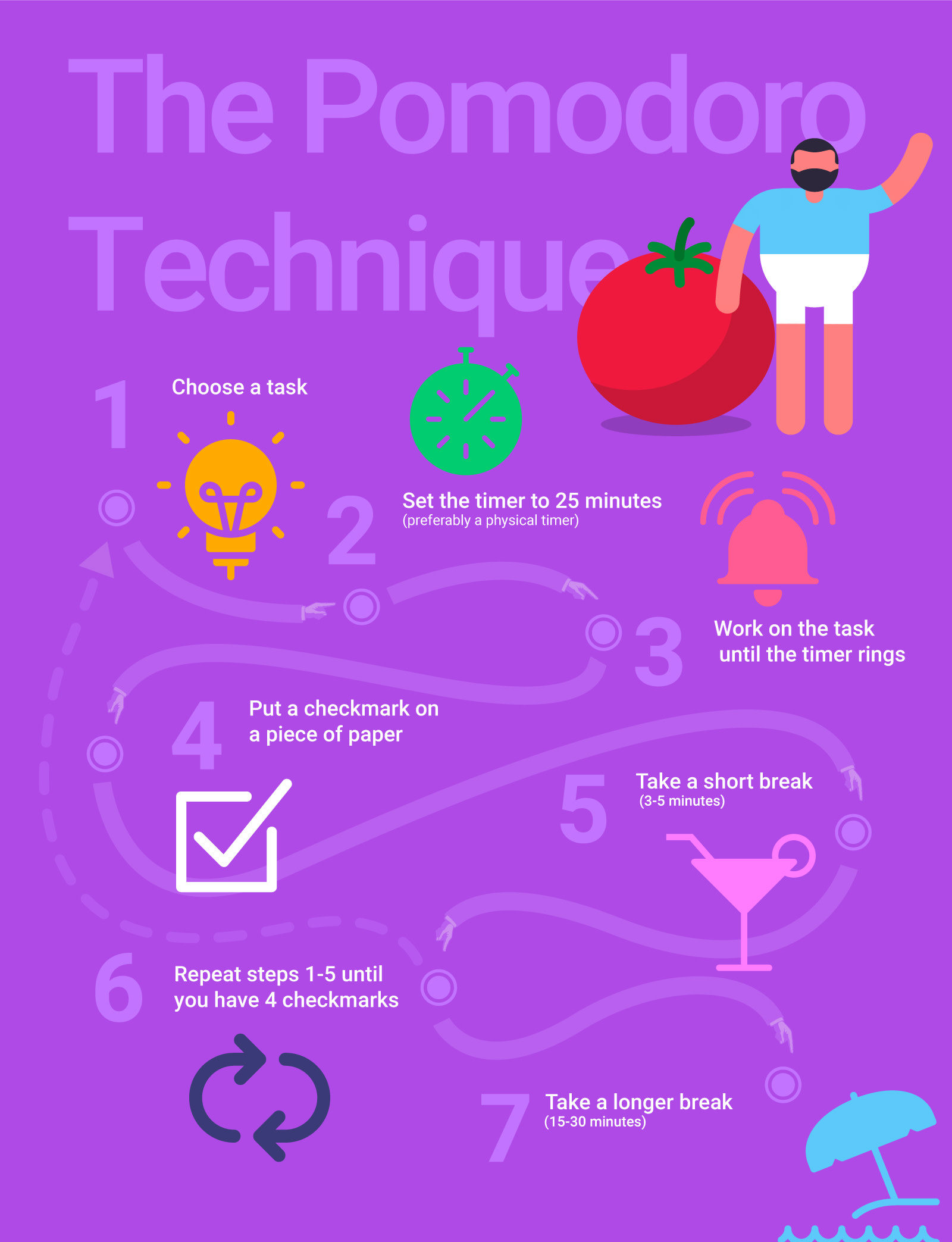Do you have a productivity hack that’s changed your life? Or did you try one that epically failed? We’re all about working smarter and achieving better results as a team. We thought it would be fun to experiment with different productivity systems to see if they really live up to the hype. When the famous Pomodoro technique came up in conversation, we knew it was the first one we had to try.
What is the Pomodoro technique?
 First, a little bit about our office environment: we work in an open space and sit at desks in groups of six. There’s a lot of noise: music, loud conversations, and even drilling and construction, since we just moved into a new office. If you need to discuss something with someone, it’s generally fair game to just pop by their desk unannounced (and yes, in essence, interrupt whatever it is they’re working on.) The result is a very informal, fast-paced, and collaborative environment. It’s fun and exciting and high-energy. The downside is that there are a lot of distractions. It’s in this environment that we tried the Pomodoro technique.
First, a little bit about our office environment: we work in an open space and sit at desks in groups of six. There’s a lot of noise: music, loud conversations, and even drilling and construction, since we just moved into a new office. If you need to discuss something with someone, it’s generally fair game to just pop by their desk unannounced (and yes, in essence, interrupt whatever it is they’re working on.) The result is a very informal, fast-paced, and collaborative environment. It’s fun and exciting and high-energy. The downside is that there are a lot of distractions. It’s in this environment that we tried the Pomodoro technique.
What happened:
Attempt #1: Epic fail
Around 10:30am on a Monday, we decided on our Pomodoro tasks. We set the timer and got started. No less than 45 seconds later, two different people simultaneously walked over to discuss separate work projects. We tried to wave them away and hissed, “We just started a Pomodoro!” but they looked at us like we were crazy and also possibly a little rude. So we apologized, explained what we were doing, and the Pomodoro was over before it had even started. Womp womp womp.
Attempt #2: Moderate Success
We realized there was no way it was going to work sitting at our desks. We had to hide from our coworkers. So we brought our laptops to a small conference room on the other side of the office and sequestered ourselves there. After reviewing the technique again in detail, we set the timer, and got to work. This attempt was much more successful. We plugged in our headphones—“Is music allowed?” Leah asked. (Yes, we think so? Unclear according to the official Pomodoro rules) and worked in total silence for 24 minutes and 15 seconds until we were interrupted again. This time, by our CEO, Roy Man. “Hey. What’s up?” “We’re trying to be productive. You just interrupted us. We had 45 seconds left.” He shrugged and we chatted for awhile. By the time he left, we were starting to get hungry, and we had to make arrangements about what to order in for lunch. Our “five-minute break” had spiraled completely out of control, but we weren’t ready to give up. We got a snack, went to the bathroom, and committed to another good 25-minute session.  This second Pomodoro went really well, aside from another tiny interruption from Roy who poked his head in to say, “Just want to give you good material for your blog post!” (Wink.) We all felt like we had gotten into a groove and were super focused when the timer went off. If anything, we wished it had lasted longer than 25 minutes. All in all, we completed two Pomodoros and completed some tasks.
This second Pomodoro went really well, aside from another tiny interruption from Roy who poked his head in to say, “Just want to give you good material for your blog post!” (Wink.) We all felt like we had gotten into a groove and were super focused when the timer went off. If anything, we wished it had lasted longer than 25 minutes. All in all, we completed two Pomodoros and completed some tasks.
- You’re forced to concentrate on a specific task: Most of us have ten million things on our to-do list, and it’s pretty rare to sit down and really concentrate on one thing. The ability to multi-task is necessary, but to produce really great work that requires creativity and thought, it helps to have uninterrupted time to focus on that task and only that task.
- It’s great for procrastinators: One of our panelists (not naming any names) has a bit of an attention deficit problem. The structure and discipline of the Pomodoro technique eliminated any excuse to procrastinate, and we found the 25-minute window to be psychologically powerful. It’s not daunting or intimidating or overwhelming; it seems doable even for someone who has a hard time focusing. In the end, even this distractible individual really liked the Pomodoro technique and said, “Let’s do another one!”
- Managing your work by time is simple and effective: Our core philosophy is that managing by time is an effective way to stay motivated and get things done. We usually think of that in terms of setting goals for the day and week, but the Pomodoro technique takes time management to a whole new level by managing actual minutes of the day. A hyper-efficient productivity machine could feasibly schedule an entire day according to Pomodoro sessions, achieving more in one day than the rest of us mere humans could hope to achieve in a lifetime.
- It’s strangely satisfying and fun: We’ve talked before about “done therapy” in monday.com—the satisfying feeling of turning something green when it’s complete—and the Pomodoro technique is that feeling on steroids. After a successful Pomodoro, you feel accomplished in the same way you might after going out for a good run.
- It’s very rigid and imposing: We had to read the Pomodoro rules several times to even understand what they meant, and then had a lot of questions about what we were “allowed” or “not allowed” to do. We wanted to get the Pomodoro technique right and believed it had a lot to offer, but had to work pretty hard at it. For us, that’s a huge red flag. This is exactly what’s wrong with so many products on the market: people feel like slaves to a master that makes them work in a certain way, and they eventually end up hating it. We built monday.com to be the antithesis of this; to make you feel free and empowered so that you can work however you want. There is no “right” or “wrong”; our goal is to make it easy for you to find whatever works best for you. The Pomodoro technique stood out in stark contrast to our flexible and customizable approach to working (and life in general.)
- Sometimes you just have to pee: Similar to the point above, it was stressful having to plan every physical and emotional need around the Pomodoro’s structure. We’re all human, and sometimes the AC needs to be adjusted or you unexpectedly get hungry. Of course the very point of the Pomodoro is to be disciplined and eliminate such distractions, but it requires a level of preparation and commitment that feels rather draconian and authoritarian.
- It’s impossible in an open office environment: If your work environment is relatively quiet and has a strict code of etiquette, the Pomodoro could be a great tool for you throughout the work day. But if you work in a casual and collaborative work environment like we do, the Pomodoro technique is nearly impossible to follow unless you get in very early or stay very late. It’s unrealistic to try to change an entire culture and environment.
- It’s a little disconnected from reality: Do you have a paper you need to write that you’ve been avoiding? Do you have a logical challenge to work through that requires a lot of focus and concentration? Then the Pomodoro technique could probably be really helpful. But chances are a lot of your most important work involves chatting with clients, scrolling through the news, collaborating with coworkers, or completing other tasks that don’t lend themselves to total isolation. The reality is is that in today’s world, you have to be able to focus and stay productive even amidst a myriad of distractions. (Reason #1,427 that adulting is hard.)
Bottom line:
If you work in a quiet environment and like discipline and structure—or perhaps don’t like it, but desperately need an intervention—then the Pomodoro technique can be an extremely effective and satisfying way to make quick progress on a project or task. It’s excellent when you have everything you need to complete your work; you just need to sit down and do it. Suffering from procrastination and anxiety? A few Pomodoro sessions should do the trick.
Would we do it again?
No. With all due respect to the Pomodoro technique and everyone it’s helped, it’s just not the right fit for us. Hopefully we can still be friends. See also: We tried it: Eat that frog (Time management technique)

